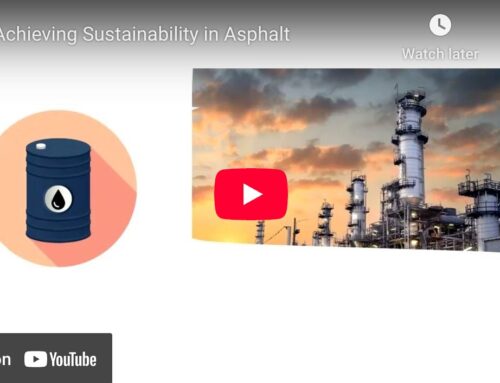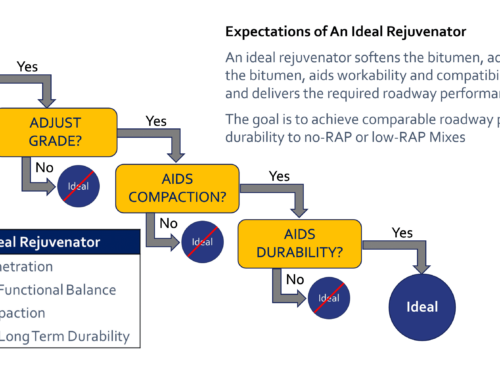
With variable bitumen quality from changes in binder sourcing impacting global asphalt producers, more engineers are moving toward balanced mix design (BMD). Rather than relying on the binder specifications alone, BMD enables producers to focus on performance testing for the final mix inclusive of aggregate, binder, modifiers, and additives.
This shift from reliance on volumetric properties alone for mix assessment means that a wider variety of tests can be performed to determine the functional characteristics of an asphalt mix. These changes in bitumen quality control have prompted labs to consider expanding their assessment capabilities through the addition of specialized equipment and trained personnel.
Here are nine of the most common bitumen and asphalt mix tests used across the industry today include:
- Penetration
- Viscosity
- Softening Point
- Performance (PG) Grading
- Specific Gravity
- Ductility
- Elastic Recovery
- Rutting Resistance
- Cracking Resistance
9 Quality Tests for Bitumen to Improve Performance
- Penetration Testing
Asphalt mix penetration testing assesses the hardness, or softness, of a roadway surface. This test includes piercing an asphalt sample with a weight of a 100-gram load. The objective is to determine how far the needle point is able to pass through the material. Results are typically reported in tenths of a millimeter. The resulting penetration grades are used to convey asphalt consistency, suitability in different climate conditions, and quality.
- Viscosity Testing
Determining viscosity can help engineers understand how an asphalt mix will flow at a particular temperature. The higher the viscosity, the closer the bitumen mix will be to a semi-solid state. Adjusting for viscosity can help with mix workability and even distribution of binder throughout the aggregates in a mix. To test viscosity, a binder sample is typically passed through a capillary tube and timed to assess how long it takes the material to flow through. Achieving preferred viscosity measures is presumed to help reduce rutting, cracking, and fatigue through prevention of binder and aggregate separation. These tests typically involve the use of viscometers.
- Softening Point
While bitumen mixes should be workable during compaction, they should also be able to resist loads once installed as part of a roadway surface. Softening point tests are used to measure the temperature at which an asphalt mix becomes too soft to withstand a set load amount. Testing typically involves heating two mix samples and placing a steel ball on top to measure the temperature and distance the weight travels into the material.
- Specific Gravity
Testing for specific gravity in a binder can provide insight into how the material will behave when subjected mix conditions. Samples are weighed and then placed in water in order to measure the sample volume. This enables engineers to determine how dense the asphalt mix is compared to water. Understanding density and air voids can help engineers formulate mixes that exhibit long-term durability and rutting resistance.
- Performance (PG) Grading
Asphalt roadway surfaces need to perform to specifications under a wide range of temperatures often in climates with extreme weather conditions. Performance Grading (PG) for asphalt is used to define rheological characteristics of the binder and determine the upper and lower temperature capability limits of the binder for service on roadways. These tests are performed using rheometers such as Dynamic Shear Rheometers (DSR) that simulate roadway conditions to determine how the binder will respond.
- Ductility
Effective roadway surfaces should balance properties for fatigue, cracking, and flexibility. Ductility testing can help assess a binder’s ability to become distorted or elongated when placed under strain. The test is often performed by stretching an asphalt binder sample until it reaches a breaking point. Higher ductility results can mean a mix is more likely to withstand stress when used in a roadway surface. Examples of tests that assess ductility include Bending Beam Rheometer (BBR), Direct Tension Tester (DTT), and Superpave Shear Tester.
- Elastic Recovery
In contrast to ductility testing, elastic recovery tests determine how well an asphalt binder sample is able to return to its original shape after being stretched, elongated, or otherwise deformed. Higher elastic recovery is believed to correlate with prolonged roadway surface life, indicating that the bitumen mix can withstand stresses that can lead to cracking or rutting. The most common test for elastic recovery is the Ductilometer test.
- Rutting Resistance
A number of different tests are used to assess the rutting resistance of asphalt mix samples. Rutting, which occurs due to pavement deformation over time, can result from several factors including poor compaction, heavy loads, and temperature extremes. Most rutting tests assess how samples respond to repeated exposure to pressure via loads applied through different methods. These tests include the Hamburg Wheel Tracking Test, IDEAL-RT, and Marshall Stability Test.
- Cracking Resistance
Another factor that can impact quality issues with asphalt is a mix’s tendency to crack. Cracking can be caused by moisture exposure, extremes in weather conditions, repeated stress from high loads, and fatigue from long periods of use. Assessing mix resistance to cracking can help create a more durable, long-lasting roadway surface. Common tests used to evaluate cracking include the Indirect Tensile Test (IDT), Semi-Circular Bending Test, IDEAL-CT Test, and Four-Point Bending Test.
Choosing the Right Bitumen Quality Tests
While the list of tests for determining bitumen quality could go on, understanding the properties that should be considered during mix design is a good place to start with the process. Not all labs will have access to every type of equipment available or needed for every test. Focusing testing protocols to correspond to project specifications can help narrow down exactly what should be measured, and how.
Factors to consider when selecting tests for bitumen quality and mix design can include:
- Mix composition such as aggregate, binder, and modifiers or additives
- Mix type including hot mix asphalt or warm mix asphalt
- Desired performance specifications
- Testing stage (i.e. pilot, quality control, mix design)
- Specimen preparation including size, homogenization, and source consistency
As departments of transportation, producers, and engineers continue to adapt their testing methods to account for the changes in bitumen quality facing the paving industry, balanced mix design and performance testing are becoming more widely used.
For more information about bitumen quality, testing, and how Sripath’s innovative portfolio of additives can help solve mix design challenges, contact info@sripath.com.





